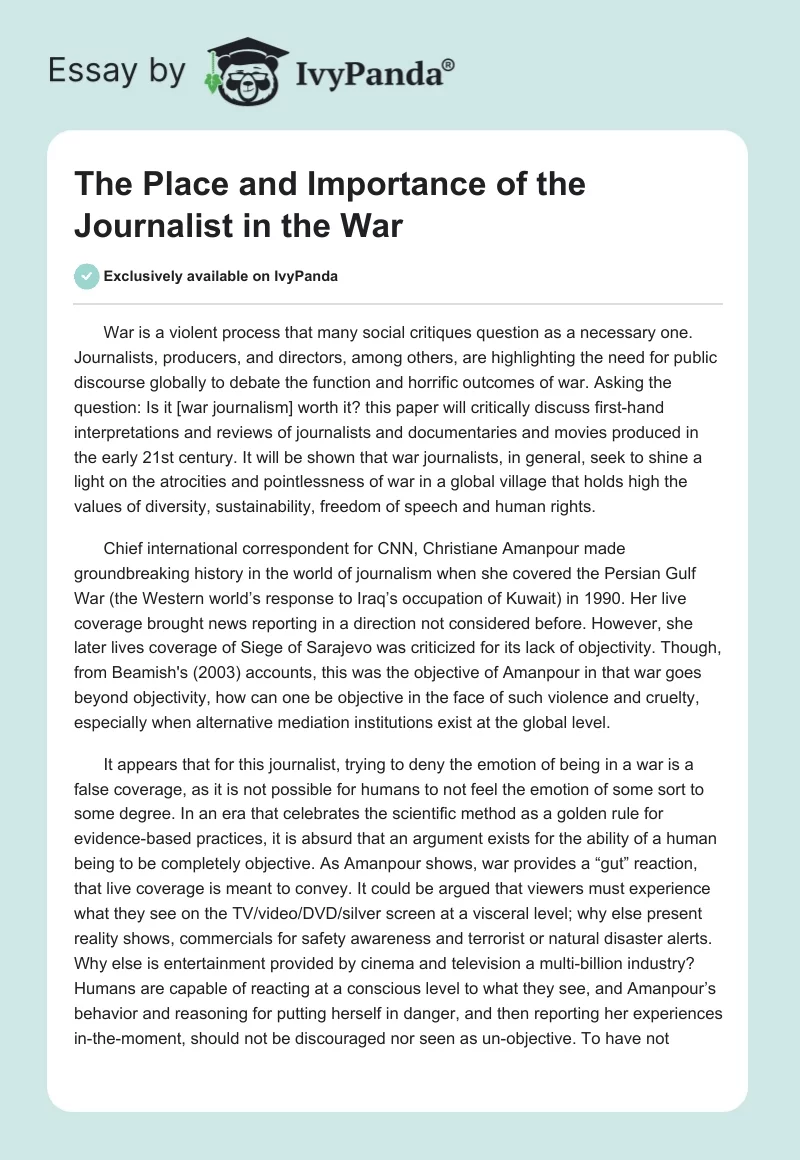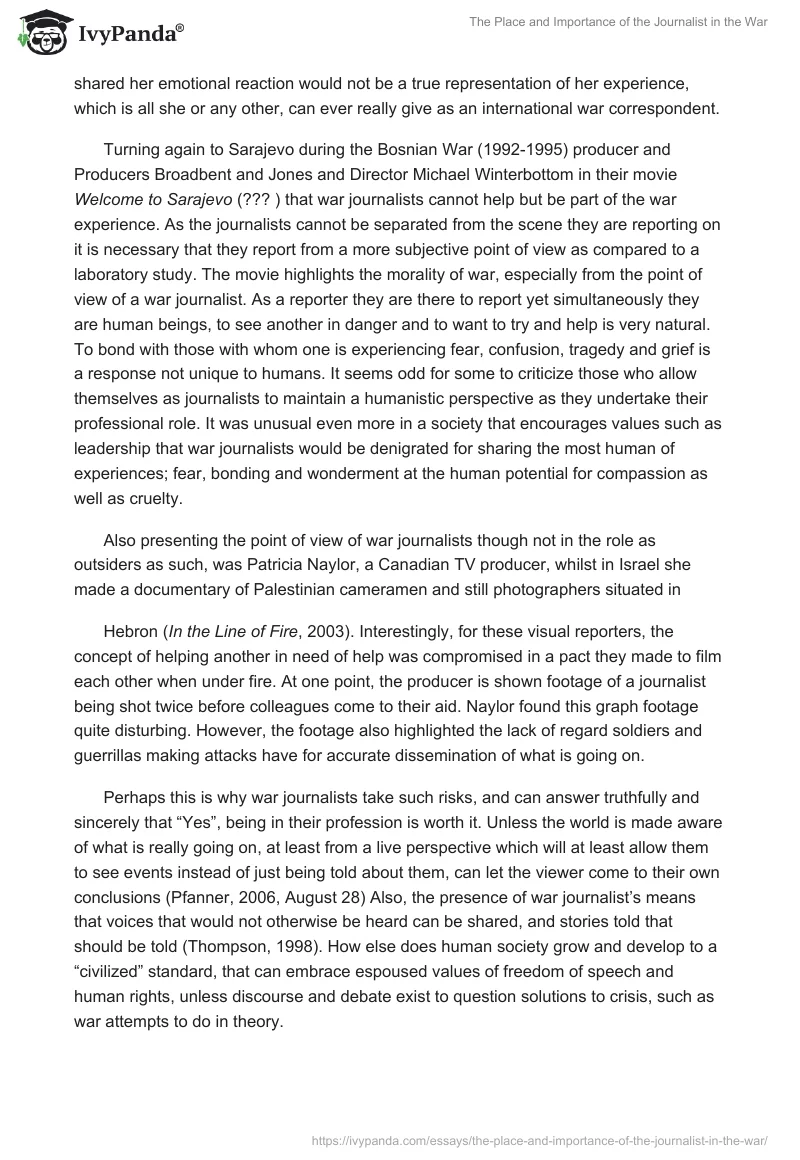War is a violent process that many social critiques question as a necessary one. Journalists, producers, and directors, among others, are highlighting the need for public discourse globally to debate the function and horrific outcomes of war. Asking the question: Is it [war journalism] worth it? this paper will critically discuss first-hand interpretations and reviews of journalists and documentaries and movies produced in the early 21st century. It will be shown that war journalists, in general, seek to shine a light on the atrocities and pointlessness of war in a global village that holds high the values of diversity, sustainability, freedom of speech and human rights.
Chief international correspondent for CNN, Christiane Amanpour made groundbreaking history in the world of journalism when she covered the Persian Gulf War (the Western world’s response to Iraq’s occupation of Kuwait) in 1990. Her live coverage brought news reporting in a direction not considered before. However, she later lives coverage of Siege of Sarajevo was criticized for its lack of objectivity. Though, from Beamish’s (2003) accounts, this was the objective of Amanpour in that war goes beyond objectivity, how can one be objective in the face of such violence and cruelty, especially when alternative mediation institutions exist at the global level.
It appears that for this journalist, trying to deny the emotion of being in a war is a false coverage, as it is not possible for humans to not feel the emotion of some sort to some degree. In an era that celebrates the scientific method as a golden rule for evidence-based practices, it is absurd that an argument exists for the ability of a human being to be completely objective. As Amanpour shows, war provides a “gut” reaction, that live coverage is meant to convey. It could be argued that viewers must experience what they see on the TV/video/DVD/silver screen at a visceral level; why else present reality shows, commercials for safety awareness and terrorist or natural disaster alerts. Why else is entertainment provided by cinema and television a multi-billion industry? Humans are capable of reacting at a conscious level to what they see, and Amanpour’s behavior and reasoning for putting herself in danger, and then reporting her experiences in-the-moment, should not be discouraged nor seen as un-objective. To have not shared her emotional reaction would not be a true representation of her experience, which is all she or any other, can ever really give as an international war correspondent.
Turning again to Sarajevo during the Bosnian War (1992-1995) producer and Producers Broadbent and Jones and Director Michael Winterbottom in their movie Welcome to Sarajevo (??? ) that war journalists cannot help but be part of the war experience. As the journalists cannot be separated from the scene they are reporting on it is necessary that they report from a more subjective point of view as compared to a laboratory study. The movie highlights the morality of war, especially from the point of view of a war journalist. As a reporter they are there to report yet simultaneously they are human beings, to see another in danger and to want to try and help is very natural. To bond with those with whom one is experiencing fear, confusion, tragedy and grief is a response not unique to humans. It seems odd for some to criticize those who allow themselves as journalists to maintain a humanistic perspective as they undertake their professional role. It was unusual even more in a society that encourages values such as leadership that war journalists would be denigrated for sharing the most human of experiences; fear, bonding and wonderment at the human potential for compassion as well as cruelty.
Also presenting the point of view of war journalists though not in the role as outsiders as such, was Patricia Naylor, a Canadian TV producer, whilst in Israel she made a documentary of Palestinian cameramen and still photographers situated in
Hebron (In the Line of Fire, 2003). Interestingly, for these visual reporters, the concept of helping another in need of help was compromised in a pact they made to film each other when under fire. At one point, the producer is shown footage of a journalist being shot twice before colleagues come to their aid. Naylor found this graph footage quite disturbing. However, the footage also highlighted the lack of regard soldiers and guerrillas making attacks have for accurate dissemination of what is going on.
Perhaps this is why war journalists take such risks, and can answer truthfully and sincerely that “Yes”, being in their profession is worth it. Unless the world is made aware of what is really going on, at least from a live perspective which will at least allow them to see events instead of just being told about them, can let the viewer come to their own conclusions (Pfanner, 2006, August 28) Also, the presence of war journalist’s means that voices that would not otherwise be heard can be shared, and stories told that should be told (Thompson, 1998). How else does human society grow and develop to a “civilized” standard, that can embrace espoused values of freedom of speech and human rights, unless discourse and debate exist to question solutions to crisis, such as war attempts to do in theory.
In conclusion, it is evident that most war journalists believe in what they are doing, hence their acceptance at placing themselves in danger. In fact, it is clear from the journalists, movie and documentary presented here that many war journalists seek to help those who are victims of war, by being present in the moments of conflict, to share their stories with a wider world that may be stirred to pressure governments for alternative solutions. Ultimately, it only by the actions of brave professionals such as journalists, cameramen and women and photographers and the like that human kind as a species will have the opportunity to learn from its mistakes and to critically reflect on its decisions and actions. In this case, it is obvious, that being a war journalist is worth it.
References
- Beamish, R. (2003) Christiane Amanpour: Why she risks her life to report from the worlds most dangerous places. Biography magazine, 7(2). P.53
- Broadbent, G & Jones, D. (Producers) & Winterbottom, M. (Director). (1998). Welcome to Serajevo [motion picture]. United States: Miramax Pictures.
- In the Line of Fire (2003) PBS: Frontline. Web.
- Pfanner, S. (2006) In London, a haven and a forum for war reporters. The New York Times. Web.
- Thompson, K. (producer &director). (1998) Dying to tell the story [Documentary Film].


